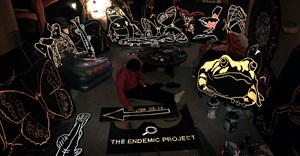Trending





 6 tips to help scale up your small businessGrant Lapping
6 tips to help scale up your small businessGrant Lapping
[Design Indaba 2012] There ain't no grave
Presenting at the closing session of the first day of Design Indaba 2012, Chris Milk, an accomplished music video producer, and Aaron Koblin, who has the enviable job description as head of the data arts team at Google Creative Lab, spoke about their collaboration in reinventing the music video using new digital thinking.
Milk admits that, although he makes music videos for a living, he has a fundamental problem with them in so far as they can never achieve the emotional resonance and memories that we attach to the original song. In contrast to the memories of that special night, that special girl, that special holiday, he identifies that a music vid can only ever be one person's vision of a song.
The quest for solutions comes in the form of the collaboration with Koblin on a landmark project - a music video for the title song off the last Johnny Cash album entitled "Ain't No Grave" [it also showcases what HTML5 is capable of - managing ed].
I've looked at clouds
Now The Johnny Cash Project demonstrates the ultimate in a democratic or cloud platform, by inviting participation from fans all over the world who get to make their unique contribution to the Johnny Cash legacy, via a black-and-white Flash drawing tool, which enables anyone to participate in an organically evolving animated tribute to the prophetic and haunting Ain't No Grave refrain.
Here the very digital technology, which may arguably be said to have been the cause of the fragmentation of the music industry, is offering the bridge for artists to connect with their followers in more meaningful and engaging ways, by allowing the music becomes "a two-way canvas".
You probably think this song is about you
The internet is allowing artists to use the music video in radical new ways. Milk's The Wilderness Downtown by Arcade Fire allows you, depending on your bandwidth and proximity to Google's Street view, to actually personalise the song to be happening in your neighbourhood, by inviting you to type in your own address. Awww!
It ain't me, babe
Other examples include Three Dreams of Black, which allows interaction with the song borrowed from new gaming technology, and the absolutely incredible video for Radiohead's House of Cards created entirely with visualised laser data.
Karmacoma, Jamaican aroma
Speaking on the second day of Indaba 2012, UK outfit United Visual Artists (UVA) spoke about the potential evolution of the live music industry - setting out to bridge the great divide between audience and stage with engagement - showing their provocative, breakthrough typographic visuals for Massive Attack.
By these means, live and recorded music have been able to move beyond one-way engagement of listen or watch - by enhancing what it has always has been: emotive, social and interactive.
Inspired by you
Big brands come to the party to make a real impact, too, such as via the 24-hour music event in which indaba presenters Hellicar & Lewis, used multi-loop interaction to enable bands such as supergroup Maroon 5 to interact with Tweets from fans to write a song, which was broadcast in real time.
The experience gained via the above project, they explain, was fundamental in allowing them to create ReacTickles and Somantics, in collaboration with Dr Wendy Keay-Bright of the Cardiff School of Art and Design - the touching and revolutionary case study showing therapeutic software for children on the autistic spectrum.
A new kind of feedback loop where we are starting to see machines play their part in enhancing human emotional responses and experiences.
Can you feel it?
Crossing over into the area of music promotion, it is worth mentioning the presentation by (primarily book designer) Paul Sahre - who wowed the Indaba audience with design so desirable you'd want to compost your Kindle.
Tasked with designing an "album cover" for They Might be Giants, his team defied the limitations of a mere iTunes thumbnail to create a mini-merchandise empire. Dissatisfied that the download should come with an A4 pdf booklet, they offered fans the opportunity to scale up the monster-truck-hearse template concept to 1400%, taking four months to follow their own instructions. The result of this ended up serving as the band's music video, and shows how in the new world order ideas can cross media, genres, scale and even the afterlife.
The end frames of the video see the cardboard monster truck being smashed at the recycling dump, but its journey did not end there, with fragments being auctioned off as cult art pieces and an ongoing internet following.
This one's goes out to...
In a way coming full circle, whereby musicians - in collaboration with their designers, video producers and techies peers - are reinventing the "concept album" in an unlimited array of engaging and interactive ways that not only promote the music itself, but also offer infinite opportunities to expand the original intentions by communicating in new and, ironically, even more personal ways than those offered by old school.
For more:
- Bizcommunity Special Section: Design Indaba
- Bizcommunity Search: Design Indaba
- Bizcommunity Galleries: Design Indaba
- Bizcommunity Twitterfall: Design Indaba
- Design Indaba website: www.designindaba.co.za
- Facebook: Design Indaba
- Twitter: @DesignIndaba
- Twitter Search: Design Indaba OR designindaba OR DI2012
- Google News Search: Design Indaba











![[Design Indaba 2012] Cities that speak](https://biz-file.com/c/1203/95915-300x156.jpg)
![[Design Indaba 2012] Andrew Shoben on how a 'design capital' should view public art](https://biz-file.com/c/1203/95776-300x156.jpg)